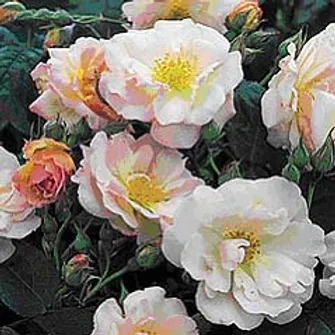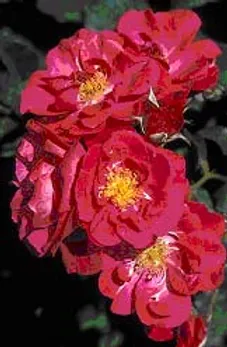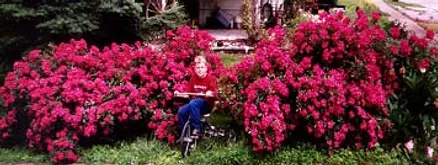Developed from relatives of the original old musk rose, ‘Rosa moschata’, Hybrid Musks (HMsk) are an increasingly favored class. Reverend Joseph Pemberton of England, and his successors Anne and Jack Bentall, using ‘Trier’ and Teas in the breeding, largely developed the HMsk class. ‘Trier’ (1904) is a descendant from ‘Aglaia’ (multiflora x ‘Rêve d’Or’ – noisette tea and musk).
Hybrid Musk roses combine exquisite fragrance, outstanding vigor, and beautiful, soft colored flowers with reliable repeat blooming, even in partial shade. They do well as gracefully spreading shrubs or low climbers, and are some of the best roses for north facing walls and fences. As a class, HMsks have almost everything to commend them.
-
The Flower: HMsk repeat well, many are remarkably floriferous. They bloom in large clusters. Individual blooms are rather small.
-
Colors: Normally, HMsk are pink, white, yellow, peach, or apricot. On a rare occasion, a medium red color can be found in HMsk.
-
Growth Habit : HMsk roses display a nice shrubby habit. Long graceful canes. Some varieties are nearly thornless. Foliage is leathery, dark green. They are tough roses that can withstand a wide range of soil conditions, temperatures and sun.
-
Size: 4 feet tall by 6 feet wide. Can be trained as climbers, or pillars or cascading shrubs.
-
Disease Resistance: Excellent. The plants are tough, disease resistant, and tolerate some shade.
-
Cold Tolerance: Most are hardy to Zones 5 through 10.
-
Scent: Normally, HMsk are quite fragrant. Scent is sweet and lingering, strongest in the evening.

Penelope . HMsk. Hybridized in 1924. ‘Ophelia’ (HT) x ‘Trier’. ARS merit rating 8.1. Flower buds are pale peachy-pink, fading to cream or white as the flower opens. Semi-double blooms. Beautiful upright yellow stamens. Large clusters of flowers. Continuous bloom. Plant has long canes that can be supported to climb, or allowed to sprawl as a low growing, spreading shrub. Will tolerate some shade. Hardy between zones 5-10. In colder areas, may have die back to the ground; own root roses improve chances of winter survival. Very fragrant. Exhibited as a classic shrub. Penelope. Reprinted with permission David Austin Roses: www.davidaustinroses.com

Will Scarlet . HMsk. Introduced in 1948. Sport of ‘Skyrocket’ (HMsk). ARS Merit Rating 8.2. Semi-double blooms. Classed as medium red. Buds are deep pink, opening to bright red blooms with striking golden stamens. It can be grown on a pillar, trellis or arbor. In the Midwest, it should reach 9 feet in height, larger in warmer climates. Hardy between zones 5-10. Repeat bloom occurs best in cooler climates. Little to no fragrance.Will Scarlet. Photo reprinted with permission Bob Bauer: http://www.rose-roses.com

Lavender Lassie . HMsk. Introduced in 1960 by Kordes. ‘ Hamburg’ (HMsk) x ‘Mme. Norbert Levavasseur’ (Polyantha). Mauve double (lilac pink). ARS Merit Rating 8.2. Repeats well in large clusters. Outstanding fragrance of an older Hybrid Musk. Can be trained as a climber. Disease free and easy to grow.
Lavender Lassie. Photo reprinted with permission Ashdown Roses: www.ashdownroses.com

Robin Hood . HMsk. 1927. ARS merit rating 8.6. Size 4′ X 3′. Slight to no fragrance. Repeat blooms wonderfully. Disease free and hardy. Tolerates a little shade and poor soil. The multitude of prickles helps to protect it from rabbit and deer damage. Makes a wonderful hedge. Robin Hood. Photo reprinted with permission: Linda Oakley Parks (Garden of Dorothy Kimmel).




























































